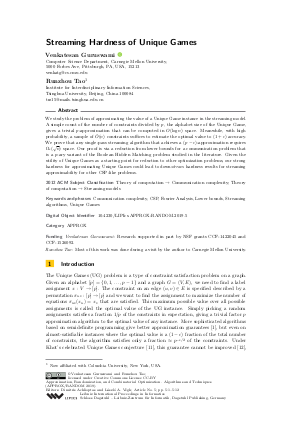Streaming Hardness of Unique Games
Authors
Venkatesan Guruswami  ,
Runzhou Tao
,
Runzhou Tao
-
Part of:
Volume:
Approximation, Randomization, and Combinatorial Optimization. Algorithms and Techniques (APPROX/RANDOM 2019)
Part of: Series: Leibniz International Proceedings in Informatics (LIPIcs)
Part of: Conference: International Conference on Randomization and Computation (RANDOM)
Part of: Conference: International Conference on Approximation Algorithms for Combinatorial Optimization Problems (APPROX) - License:
 Creative Commons Attribution 3.0 Unported license
Creative Commons Attribution 3.0 Unported license
- Publication Date: 2019-09-17
File

PDF
LIPIcs.APPROX-RANDOM.2019.5.pdf
- Filesize: 476 kB
- 12 pages
Document Identifiers
Subject Classification
ACM Subject Classification
- Theory of computation → Communication complexity
- Theory of computation → Streaming models
Keywords
- Communication complexity
- CSP
- Fourier Analysis
- Lower bounds
- Streaming algorithms
- Unique Games
Metrics
- Access Statistics
-
Total Accesses (updated on a weekly basis)
0Document
0Metadata
Abstract
We study the problem of approximating the value of a Unique Game instance in the streaming model. A simple count of the number of constraints divided by p, the alphabet size of the Unique Game, gives a trivial p-approximation that can be computed in O(log n) space. Meanwhile, with high probability, a sample of O~(n) constraints suffices to estimate the optimal value to (1+epsilon) accuracy. We prove that any single-pass streaming algorithm that achieves a (p-epsilon)-approximation requires Omega_epsilon(sqrt n) space. Our proof is via a reduction from lower bounds for a communication problem that is a p-ary variant of the Boolean Hidden Matching problem studied in the literature. Given the utility of Unique Games as a starting point for reduction to other optimization problems, our strong hardness for approximating Unique Games could lead to downstream hardness results for streaming approximability for other CSP-like problems.
Cite As Get BibTex
Venkatesan Guruswami and Runzhou Tao. Streaming Hardness of Unique Games. In Approximation, Randomization, and Combinatorial Optimization. Algorithms and Techniques (APPROX/RANDOM 2019). Leibniz International Proceedings in Informatics (LIPIcs), Volume 145, pp. 5:1-5:12, Schloss Dagstuhl – Leibniz-Zentrum für Informatik (2019)
https://doi.org/10.4230/LIPIcs.APPROX-RANDOM.2019.5
BibTex
@InProceedings{guruswami_et_al:LIPIcs.APPROX-RANDOM.2019.5,
author = {Guruswami, Venkatesan and Tao, Runzhou},
title = {{Streaming Hardness of Unique Games}},
booktitle = {Approximation, Randomization, and Combinatorial Optimization. Algorithms and Techniques (APPROX/RANDOM 2019)},
pages = {5:1--5:12},
series = {Leibniz International Proceedings in Informatics (LIPIcs)},
ISBN = {978-3-95977-125-2},
ISSN = {1868-8969},
year = {2019},
volume = {145},
editor = {Achlioptas, Dimitris and V\'{e}gh, L\'{a}szl\'{o} A.},
publisher = {Schloss Dagstuhl -- Leibniz-Zentrum f{\"u}r Informatik},
address = {Dagstuhl, Germany},
URL = {https://drops.dagstuhl.de/entities/document/10.4230/LIPIcs.APPROX-RANDOM.2019.5},
URN = {urn:nbn:de:0030-drops-112209},
doi = {10.4230/LIPIcs.APPROX-RANDOM.2019.5},
annote = {Keywords: Communication complexity, CSP, Fourier Analysis, Lower bounds, Streaming algorithms, Unique Games}
}
Author Details
- Computer Science Department, Carnegie Mellon University, 5000 Forbes Ave, Pittsburgh, PA, USA, 15213
Funding
- Guruswami, Venkatesan: Research supported in part by NSF grants CCF-1422045 and CCF-1526092.
- Tao, Runzhou: Most of this work was done during a visit by the author to Carnegie Mellon University.
References
-
Moses Charikar, Konstantin Makarychev, and Yury Makarychev. Near-optimal algorithms for unique games. In Proceedings of the 38th Annual ACM Symposium on Theory of Computing, pages 205-214, 2006.

-
Irit Dinur, Subhash Khot, Guy Kindler, Dor Minzer, and Muli Safra. Towards a proof of the 2-to-1 games conjecture? In Proceedings of the 50th Annual ACM Symposium on Theory of Computing, pages 376-389, 2018.

-
Uriel Feige and Daniel Reichman. On Systems of Linear Equations with Two Variables per Equation. In Approximation, Randomization, and Combinatorial Optimization, Algorithms and Techniques (APPROX, RANDOM), pages 117-127, 2004.

-
Dmitry Gavinsky, Julia Kempe, Iordanis Kerenidis, Ran Raz, and Ronald De Wolf. Exponential separations for one-way quantum communication complexity, with applications to cryptography. In Proceedings of the 39th annual ACM symposium on Theory of computing, pages 516-525. ACM, 2007.

-
Venkatesan Guruswami, Johan Håstad, Rajsekar Manokaran, Prasad Raghavendra, and Moses Charikar. Beating the Random Ordering Is Hard: Every Ordering CSP Is Approximation Resistant. SIAM Journal on Computing, 40(3):878-914, 2011.

-
Venkatesan Guruswami, Rajsekar Manokaran, and Prasad Raghavendra. Beating the Random Ordering is Hard: Inapproximability of Maximum Acyclic Subgraph. In Proceedings of the 49th Annual IEEE Symposium on Foundations of Computer Science, pages 573-582, 2008.

-
Venkatesan Guruswami, Ameya Velingker, and Santhoshini Velusamy. Streaming complexity of approximating Max 2CSP and Max Acyclic Subgraph. In 20th International Workshop on Approximation Algorithms for Combinatorial Optimization Problems (APPROX), pages 8:1-8:19, 2017.

-
Jeff Kahn, Gil Kalai, and Nathan Linial. The influence of variables on Boolean functions. In Proceedings of the 29th Annual Symposium on Foundations of Computer Science, pages 68-80, 1988.

-
Michael Kapralov, Sanjeev Khanna, and Madhu Sudan. Streaming lower bounds for approximating MAX-CUT. In Proceedings of the 26 annual ACM-SIAM symposium on Discrete Algorithms, pages 1263-1282. Society for Industrial and Applied Mathematics, 2015.

-
Michael Kapralov and Dmitry Krachun. An Optimal Space Lower Bound for Approximating MAX-CUT. In Proceedings of the 51st Annual ACM SIGACT Symposium on Theory of Computing, STOC 2019, pages 277-288, 2019.

-
Subhash Khot. On the power of unique 2-prover 1-round games. In Proceedings on 34th Annual ACM Symposium on Theory of Computing, pages 767-775, 2002.

-
Subhash Khot, Guy Kindler, Elchanan Mossel, and Ryan O'Donnell. Optimal Inapproximability Results for MAX-CUT and Other 2-Variable CSPs? SIAM Journal on Computing, 37(1):319-357, 2007.

-
Ryan O'Donnell. Analysis of boolean functions. Cambridge University Press, 2014.

-
Alessandro Panconesi and Aravind Srinivasan. Randomized Distributed Edge Coloring via an Extension of the Chernoff-Hoeffding Bounds. SIAM Journal on Computing, 26(2):350-368, 1997.

-
Khot Subhash, Dor Minzer, and Muli Safra. Pseudorandom sets in grassmann graph have near-perfect expansion. In 2018 IEEE 59th Annual Symposium on Foundations of Computer Science (FOCS), pages 592-601. IEEE, 2018.

-
Elad Verbin and Wei Yu. The streaming complexity of cycle counting, sorting by reversals, and other problems. In Proceedings of the 26 annual ACM-SIAM symposium on Discrete Algorithms, pages 11-25, 2011.

